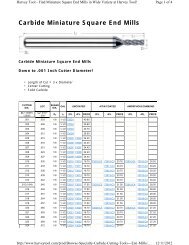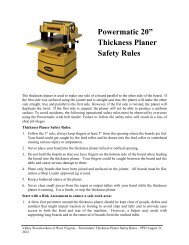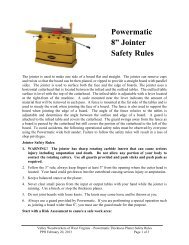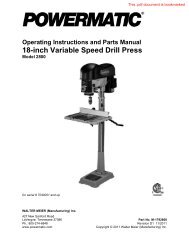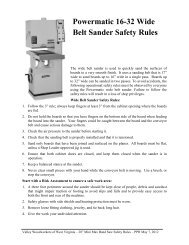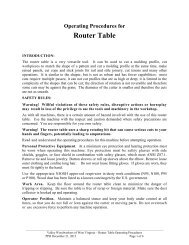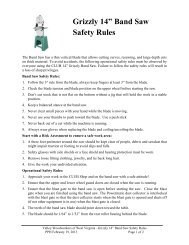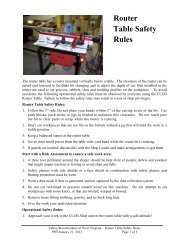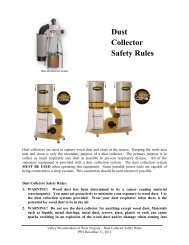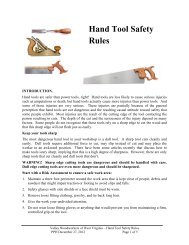Mini Max MM20 Band S.. - Valley Woodworkers
Mini Max MM20 Band S.. - Valley Woodworkers
Mini Max MM20 Band S.. - Valley Woodworkers
Create successful ePaper yourself
Turn your PDF publications into a flip-book with our unique Google optimized e-Paper software.
WIDTHS: Common blade widths are 1 1/4", 1", 3/4", 1/2", 3/8" ,1/4" , 1/8", 1/16"<br />
You will find that 1", 1/2", 1/4" blades cover a wide range of woodworking tasks.<br />
TEETH: The number of teeth per inch of blade (TPI) will range from 3 TPI to as<br />
high as 14 TPI. Rough work and very thick wood uses fewer TPI while narrower<br />
widths and fine work use higher TPI.<br />
TOOTH TYPE: Hook/Skip type are good for re-sawing, ripping or joinery<br />
BLADE TYPES:Blades can be had in carbon steel, Bi-metal or carbide tipped<br />
blades. General woodworking needs can be met with a variety of types. Both<br />
Carbon steel and Bimetal can be very effective. Carbide blades are a powerful<br />
addition to resaw capability but must be suited to the saw.For example, the 1”<br />
wide carbide blade offered by <strong>Mini</strong> <strong>Max</strong> is not recommended for the MM16<br />
because the smaller wheel radius flexes and work hardens the blade leading to<br />
premature breakage before dulling. A 1” Carbide is however very well suited and<br />
effective on the <strong>MM20</strong> and larger saws.<br />
Note: <strong>Mini</strong> <strong>Max</strong> sells the Olson line of bandsaw blades. other options are offered<br />
in our sources section.<br />
GUIDE INSPECTION AND ADJUSTMENT<br />
The guides are European ball-bearing type For very narrow width blades,<br />
<strong>Mini</strong><strong>Max</strong> is developing a “cool block” guide system for using 1/8" and smaller<br />
blades<br />
LOWER GUIDES<br />
On the MM16 or <strong>MM20</strong>, remove the lower guides. (See Figure12 Lower Guides)<br />
This is a good chance to check to see if the guides are cleaned of the Cosmoline!<br />
Loosen the allen screws (in the back) that hold the guides to the aluminum<br />
bracket. Align the guides and tighten the allen screws.<br />
Back the guides off and then move them back together<br />
to double check the adjustment before re-installing the<br />
guides. While the guides<br />
are out, sight them from<br />
the top to make sure the<br />
two guides are toed in<br />
slightly towards the front.<br />
(this is what makes them<br />
spin and captures the<br />
blade just behind the<br />
gullets) If they are not,or the<br />
guide wheels spin in opposite<br />
directions when the saw is run with a blade installed, call the Austin Office to<br />
report it and get instructions for a fix.<br />
UPPER GUIDES<br />
starting with the top guides ( See Figure 13 Upper Guides)<br />
1).Screw the two side guides in and make sure they are meeting up<br />
with each other like stacking coins. If they do not match up, loosen the<br />
two allen screws from the back and then adjust (twist) the guides so<br />
6



